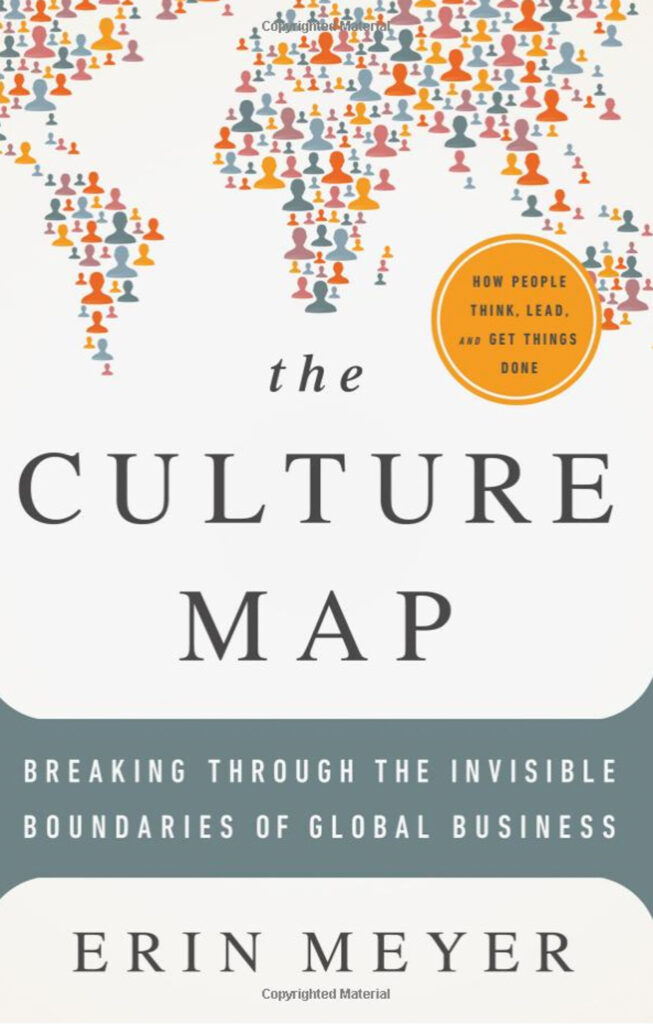When I guest lecture on Intercultural Leadership at the McCombs School of Business at the University of Texas in Austin, I discuss with the students the cultural challenges I faced as a global leader. I also advise that many of them will transition into global roles at some point during their careers. Unfortunately, companies rarely provide leaders with the training and tools needed to effectively lead through diverse cultures. Erin Meyer in her book The Culture Map provides us with the tools and methods needed to successfully communicate, persuade, decide, and lead across cultures.
Ms. Meyer is a professor at INSEAD, one of the world’s leading international business schools. Her research is focused on determining how the world’s most successful global leaders navigate the complexities of cultural differences. Her framework allows executives around the world to pinpoint their leadership preferences, and compare their methods to the management styles of other cultures. This helps them navigate complex leadership issues, negotiate successfully across cultures, and solve issues that require years of experience. As a result, this book is one of my most prescribed books for leaders facing cultural challenges.
The Culture Map details “Eight Scales that Map the World’s Cultures” and points out that these scales are beyond our inherent preferences. The author points out that there is a relative value within each scale. This indicates that you can have two cultures on the same end of the scale, but one culture could be more or less given its relative value to its neighbor on the scale. There is also a concept of grouping where similar cultures are grouped within the scale.
For each scale, the author offers examples of cultural differences and suggests how to approach these differences effectively. The eight scales are as follows:
Chapter 1 – Communicating: Low-Context cultures communicate precisely, simply, and clearly. The communication is taken at face value and in some cases, repetition is appreciated, especially if it helps clarify communication. High-Context cultures, on the other hand, are cultures where communication is more sophisticated, nuanced, and layered. For these cultures, you may have to read between the lines as messages may be implied.
Chapter 2 – Evaluating: In this chapter, she covers a topic that is a common challenge to all global leaders, evaluating performance, and providing negative feedback across cultures. On one end of the spectrum, there are cultures with a “direct negative feedback” style. This feedback, which may be delivered in public, is delivered “frankly, bluntly and honestly”, and “negative messages stand-alone”, and are “not softened by positive ones.” On the other end of the spectrum, there are cultures with “Indirect negative feedback.” These cultures deliver feedback “softly, subtly and diplomatically” and “positive messages are used to wrap negative ones.” Criticism is given only in private.
Chapter 3 – Persuading: Every business is filled with opportunities to persuade others. This is especially true in sales. Trying to persuade others across cultures can be challenging. There is no universal approach and “the art of persuasion is one that is profoundly culture-based.” In a “principles-first” culture, the theory or concept are presented before a fact, statement or opinion. They tend to “build up a theoretical argument before moving to the conclusion.” In an applications-first culture, the individual will begin with a fact, statement or opinion first, then “later add concepts to back up or explain the conclusion as necessary.”
Chapter 4 – Leading: As I think back through my career, the “egalitarian” vs. “hierarchical” approach to leadership stands out. In egalitarian cultures, the “distance between ta boss and subordinate is low”, “organizational structures are flat” and “communication often skips hierarchical lines.” On the other end of the spectrum, hierarchical cultures are those where the “distance between a boss and a subordinate is high”, the boss is a strong director who leads from the front”, and “status is important. Communication then “follows set hierarchical lines.” Often, US corporations operating abroad have open-door policies that clearly step on this cultural nuance.
Chapter 5 – Deciding: Making decisions is a critical component of running a business. In this chapter, the author describes “Consensual” cultures as those where “decisions are made in groups through unanimous agreement” and “Top-Down” cultures as those where “decisions are made by individuals (usually the boss).” As you can imagine there is a speed of decision issue that rises with the former. She points out that “these differing styles of decision making have a dramatic impact on the timeline of a typical project.” This is something to consider if you are making project-based decisions in a consensus-based culture.
Chapter 6 – Trusting: This is the most important scale and it’s also one of the most complex. Building trust across cultures is a delicate task and it requires a lot of cultural knowledge. The author describes the trust continuum as task-based on one end and Relationship-based on the other. task-based cultures are those where “Trust is built through business-related activities”, compared to relationship-based cultures that are “built through sharing meals, evening drinks, and visits at the coffee machine.” This is a very wide gap and failure to understand these differences can lead to difficulties in building fruitful relationships.
Chapter 7 – Disagreeing: Finding ways to “disagree productively” requires in-depth knowledge of the cultural nuances and failure to understand them can lead to some significant misunderstandings. Confrontational cultures are those where “disagreement and debate are positive for the team or organization” while those cultures who avoid confrontation find that “disagreement and debate are negative for the team or organization.” While some cultures value open confrontation, many don’t. It’s important to understand which ones do and which ones don’t.
Chapter 8 – Scheduling: This one is important for leaders who are dealing with timelines and deadlines. This scale deals with cultures that value “linear-time” and those who value “flexible-time.” Linear-time cultures are those where “project steps are approached in a sequential fashion, completing one task before beginning the next”, while cultures who value flexible time are those where “project steps are approached in a fluid manner, changing tasks as opportunities arise.”
In her epilogue, she recommends that we assemble a culture map to “bridge the fault lines” of the cultural differences we are facing. She offers, for a fee, a Country Mapping Tool on her website to do just that. This tool allows you to compare two or more cultures at once. The pricing is reasonable and itis well worth it, especially if you are working on a complex cultural dilemma.
This is a great book to read if you are struggling with leadership or business issues across cultures. It provides you with the tools needed to navigate complex leadership challenges and to achieve the desired business outcomes.
I hope this book review has been useful and that you can put the information contained in the book to good use in your leadership journey. Drop me a note if you have any questions on how to apply this to your role.
Thanks,




